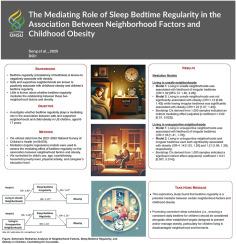The mediating role of sleep bedtime regularity in the association between neighborhood factors and childhood obesity
IF 3.4
2区 医学
Q1 CLINICAL NEUROLOGY
引用次数: 0
Abstract
Background
Regular bedtime patterns have been inversely associated with obesity. In turn, safe and supportive neighborhoods positively associate with children's bedtime regularity. We sought to determine whether bedtime regularity mediates between these two neighborhood factors and obesity among US children aged 6–17.
Methods
Using data from the 2021-22 National Survey of Children's Health (n = 59,078), two mediation models tested the effect of bedtime regularity on associations between neighborhood factors and obesity. Both models adjusted for sex, age, race/ethnicity, household poverty, physical activity, and caregiver's education. Caregivers reported on neighborhood factors, obesity, and sleep.
Results
Unsafe neighborhoods: In Model 1, living in unsafe neighborhoods associated with irregular bedtime (OR = 1.82 [95 % CI: 1.46, 2.28]). In Model 2, living in unsafe neighborhoods did not significantly associate with obesity (OR = 1.12 [0.89, 1.40]); irregular bedtime significantly associated with obesity (OR = 1.22 [1.07, 1.40]). Bootstrap CIs derived from 1000 samples indicated a significant indirect mediating effect (adjusted β = 0.02 [0.01, 0.022]). Unsupportive neighborhoods: In Model 1, living in unsupported neighborhoods associated with irregular bedtime (OR = 1.58 [1.41, 1.76]). In Model 2, living in unsupported neighborhoods and irregular bedtime significantly associated with obesity (OR = 1.14 [1.03, 1.26] and 1.21 [1.06, 1.39]). Bootstrap CIs indicated a significant indirect mediating effect (adjusted β = 0.01 [0.007, 0.014]).
Conclusions
Our findings highlight the impact of living in disadvantaged neighborhoods and suggest promoting bedtime regularity may be a suitable obesity intervention target for youth living in these settings. Due to the small effect sizes and the cross-sectional design of our study, our findings should be considered along with other established targets.

睡眠就寝规律在邻里因素与儿童肥胖关系中的中介作用
有规律的就寝时间与肥胖呈负相关。反过来,安全和支持的社区与孩子的就寝规律呈正相关。我们试图确定在6-17岁的美国儿童中,就寝时间规律是否在这两个邻里因素和肥胖之间起中介作用。方法利用《2021- 2022年全国儿童健康调查》(n = 59078)的数据,采用两个中介模型检验就寝时间规律对邻里因素与肥胖之间关系的影响。两个模型都根据性别、年龄、种族/民族、家庭贫困、体育活动和看护者的教育程度进行了调整。护理人员报告了邻里因素、肥胖和睡眠。结果:在模型1中,生活在不安全的社区与不规律的就寝时间有关(OR = 1.82 [95% CI: 1.46, 2.28])。在模型2中,居住在不安全社区与肥胖没有显著相关(OR = 1.12 [0.89, 1.40]);睡眠时间不规律与肥胖显著相关(OR = 1.22[1.07, 1.40])。来自1000个样本的Bootstrap CIs显示了显著的间接中介效应(调整后的β = 0.02[0.01, 0.022])。不支持的社区:在模型1中,生活在不支持的社区与不规律的就寝时间相关(OR = 1.58[1.41, 1.76])。在模型2中,生活在无支持社区和不规律的就寝时间与肥胖显著相关(OR = 1.14[1.03, 1.26]和1.21[1.06,1.39])。Bootstrap CIs具有显著的间接中介效应(经校正的β = 0.01[0.007, 0.014])。结论我们的研究结果强调了生活在弱势社区的影响,并提示促进就寝规律可能是生活在这些环境中的青少年肥胖干预的合适目标。由于本研究的效应量较小且为横断面设计,我们的研究结果应与其他既定目标一起考虑。
本文章由计算机程序翻译,如有差异,请以英文原文为准。
求助全文
约1分钟内获得全文
求助全文
来源期刊

Sleep medicine
医学-临床神经学
CiteScore
8.40
自引率
6.20%
发文量
1060
审稿时长
49 days
期刊介绍:
Sleep Medicine aims to be a journal no one involved in clinical sleep medicine can do without.
A journal primarily focussing on the human aspects of sleep, integrating the various disciplines that are involved in sleep medicine: neurology, clinical neurophysiology, internal medicine (particularly pulmonology and cardiology), psychology, psychiatry, sleep technology, pediatrics, neurosurgery, otorhinolaryngology, and dentistry.
The journal publishes the following types of articles: Reviews (also intended as a way to bridge the gap between basic sleep research and clinical relevance); Original Research Articles; Full-length articles; Brief communications; Controversies; Case reports; Letters to the Editor; Journal search and commentaries; Book reviews; Meeting announcements; Listing of relevant organisations plus web sites.
 求助内容:
求助内容: 应助结果提醒方式:
应助结果提醒方式:


